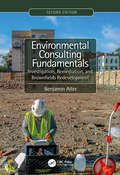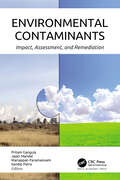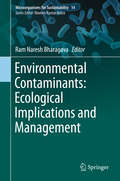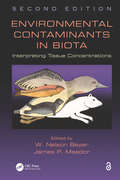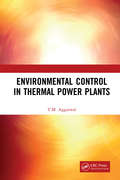- Table View
- List View
Environmental Condition of the Mediterranean Sea: European Community Countries (Environment & Assessment #5)
by W. J. Heinen M. Nikolopoulou-Tamvakli F. B. WalleThis study investigates the extent of the pollution of the Mediterranean Sea with respect to the four bordering EC countries - spain, France, Italy, and Greece. The environmental pressures and economic impacts are examined and the institutional/legal framework is described together with all the necessary environmental expenditures. The book is written in such a way that separate chapters are devoted to each of the four countries, after an initial section summarizing the major commonalities. These chapters are organized in parallel formats so that it is possible to examine the same topic country by country. Good references are provided for the reader who is not familiar with the subject of Mediterranean pollution. For specialists, the book provides a useful overview of adjacent fields other than their own speciality: for policymakers, the chapters provide sufficient foundations for decision-making: for the investment planner and banks, it provides budget and investment needs; and for the private sector, it gives an insight into the possibilities for corporate applications of environmental technologies. Four specialists - Prof. V. Silano (Italy), Dr. M. Vassilopoulos (Greece), Dr. L.A. Romafia (France), and Mr. A. Estevan (Spain- contributed sustantially by evaluating the necessary information from national documents on environmental policies and strategies. The book was developed on the basis of an integrated environmental study financed by the European Investment Bank, to which we would like to express our sincere thanks.
Environmental Conflict and Cooperation: Premise, Purpose, Persuasion, and Promise
by James R. LeeEnvironmental Conflict and Cooperation explores the evolution of environmental conflict as a field of research and the study of cooperation as an alternative to war. Over four key parts, James R. Lee navigates the contours of this growing field and paints a vivid framework for better understanding issues around environmental conflict and security: • The premise of the field and its historic manifestations • The definition and purpose of research • The persuasions or types of environmental conflict and cooperation • The promise of research in leading to better decision-making and to broaching new challenges. Over the course of these parts, the author outlines the deep historic record of this discipline, arguing that it will play a key role in understanding important future trends. Utilizing a wide variety of case studies that range from ancient examples, including conflict over the Cedars of Lebanon and the role of tin in the Peloponnesian Wars, to future-oriented scenarios, including expanded island-building in the South China Sea and the global politics of geo-engineering, Lee highlights key concepts, metrics, and policy contexts that will test current understandings. He also examines a variety of research methods and provides examples of the ways in which such research can be used to inform policy improvements. This book will draw specific interest from students and scholars of environmental conflict and cooperation, as well as researchers of environmental politics and security studies.
Environmental Conflict and Cooperation: Premise, Purpose, Persuasion, and Promise
by James R. LeeEnvironmental Conflict and Cooperation explores the evolution of environmental conflict as a field of research and the study of cooperation as an alternative to war. Over four key parts, James R. Lee navigates the contours of this growing field and paints a vivid framework for better understanding issues around environmental conflict and security: • The premise of the field and its historic manifestations • The definition and purpose of research • The persuasions or types of environmental conflict and cooperation • The promise of research in leading to better decision-making and to broaching new challenges. Over the course of these parts, the author outlines the deep historic record of this discipline, arguing that it will play a key role in understanding important future trends. Utilizing a wide variety of case studies that range from ancient examples, including conflict over the Cedars of Lebanon and the role of tin in the Peloponnesian Wars, to future-oriented scenarios, including expanded island-building in the South China Sea and the global politics of geo-engineering, Lee highlights key concepts, metrics, and policy contexts that will test current understandings. He also examines a variety of research methods and provides examples of the ways in which such research can be used to inform policy improvements. This book will draw specific interest from students and scholars of environmental conflict and cooperation, as well as researchers of environmental politics and security studies.
Environmental Consequences of War and Aftermath (The Handbook of Environmental Chemistry #3 / 3U)
by Tarek A. Kassim Damià Barcelóand used in munitions. Rather the requirements for the agent’s military effects took precedence. In addition, the interaction among the political, technical, and legal challenges connected with the known or possible risks posed by CW agents is complex and sometimes not well understood. This is usually because technical considerations, when acted on, are almost invariably informed by political ones, such as various legal requirements. The book contains nine chapters covering different aspects of the research on environmental consequences of war and its aftermath and covers in one additional chapter more general issues such as prevention of war and its environmental c- sequences, the legal, political, and technical background to selected environmental and human health effects of CW agents, and the atmospheric transport and depo- tion of persistent organic pollutants under warfare conditions to more specific ones related to two main tragic examples: the war in the Balkans and the Gulf War. Aspects of the war in the Balkans cover contamination by heavy metals in Serbian national parks, the impact of NATO strikes on the Danube river basin, and the problems associated with transuranium elements. The Gulf War in Kuwait covers other problems related to the impact of oil contamination, the impact on grou- water resources, and the soil damage of ground fortifications among other envir- mental and health problems.
Environmental Considerations Associated with Hydraulic Fracturing Operations: Adjusting to the Shale Revolution in a Green World
by James A. Jacobs Stephen M. TestaA guide to environmental and communication issues related to fracking and the best approach to protect communities Environmental Considerations Associated with Hydraulic Fracturing Operations offers a much-needed resource that explores the complex challenges of fracking by providing an understanding of the environmental and communication issues that are inherent with hydraulic fracturing. The book balances the current scientific knowledge with the uncertainty and risks associated with hydraulic fracking. In addition, the authors offer targeted approaches for helping to keep communities safe. The authors include an overview of the historical development of hydraulic fracturing and the technology currently employed. The book also explores the risk, prevention, and mitigation factors that are associated with fracturing. The authors also include legal cases, regulatory issues, and data on the cost of recovery. The volume presents audit checklists for gathering critical information and documentation to support the reliability of the current environmental conditions related to fracking operations and the impact fracking can have on a community. This vital resource: Contains the technical information and mitigation recommendations for safety and environmental issues related to hydraulic fracturing Offers an historical overview of conventional and unconventional oil and gas drilling Explains the geologic and technical issues associated with fracking of tight sand and shale formulations Presents numerous case studies from the United States EPA and other agencies Discusses issues of co-produced waste water and induced seismicity from the injection of wastewater Written for environmental scientists, geologists, engineers, regulators, city planners, attorneys, foresters, wildlife biologists, and others, Environmental Considerations Associated with Hydraulic Fracturing Operations offers a comprehensive resource to the complex environmental and communication issues related to fracking.
Environmental Considerations Associated with Hydraulic Fracturing Operations: Adjusting to the Shale Revolution in a Green World
by James A. Jacobs Stephen M. TestaA guide to environmental and communication issues related to fracking and the best approach to protect communities Environmental Considerations Associated with Hydraulic Fracturing Operations offers a much-needed resource that explores the complex challenges of fracking by providing an understanding of the environmental and communication issues that are inherent with hydraulic fracturing. The book balances the current scientific knowledge with the uncertainty and risks associated with hydraulic fracking. In addition, the authors offer targeted approaches for helping to keep communities safe. The authors include an overview of the historical development of hydraulic fracturing and the technology currently employed. The book also explores the risk, prevention, and mitigation factors that are associated with fracturing. The authors also include legal cases, regulatory issues, and data on the cost of recovery. The volume presents audit checklists for gathering critical information and documentation to support the reliability of the current environmental conditions related to fracking operations and the impact fracking can have on a community. This vital resource: Contains the technical information and mitigation recommendations for safety and environmental issues related to hydraulic fracturing Offers an historical overview of conventional and unconventional oil and gas drilling Explains the geologic and technical issues associated with fracking of tight sand and shale formulations Presents numerous case studies from the United States EPA and other agencies Discusses issues of co-produced waste water and induced seismicity from the injection of wastewater Written for environmental scientists, geologists, engineers, regulators, city planners, attorneys, foresters, wildlife biologists, and others, Environmental Considerations Associated with Hydraulic Fracturing Operations offers a comprehensive resource to the complex environmental and communication issues related to fracking.
Environmental Consulting Fundamentals: Investigation, Remediation, and Brownfields Redevelopment, Second Edition
by Benjamin AlterThis book is a primer for those interested in a career in this dynamic, multidisciplinary field as well as a handy reference for practicing consultants. Combining theory and practice advice into a concise, readable format, the book is an accessible introduction to the types of projects you will encounter as an environmental consultant and lays the groundwork for what you’ll need to know in this challenging and rewarding profession. Also available with this book, under the Additional Resourcs tab, are PowerPoint lectures that correspond with each chapter. New in the Second Edition Covers the latest environmental issues, including emerging contaminants, and the latest technological advances in environmental investigation and remediation New chapters dedicated to vapor intrusion investigation and mitigation and to Brownfields redevelopment and project financing. An expanded chapter describing the staffing, budgeting, and execution of environmental projects. Descriptions of the remediation processes under RCRA and Superfund Descriptions on how each chapter’s subject matter applies to the job of the environmental consultant. Dozens of new figures, photographs, and tables designed to enhance the reader’s understanding of the subject matter. Problems and questions to be used for homework assignments or classroom discussions.
Environmental Consulting Fundamentals: Investigation, Remediation, and Brownfields Redevelopment, Second Edition
by Benjamin AlterThis book is a primer for those interested in a career in this dynamic, multidisciplinary field as well as a handy reference for practicing consultants. Combining theory and practice advice into a concise, readable format, the book is an accessible introduction to the types of projects you will encounter as an environmental consultant and lays the groundwork for what you’ll need to know in this challenging and rewarding profession. Also available with this book, under the Additional Resources tab, are PowerPoint lectures that correspond with each chapter. New in the Second Edition Covers the latest environmental issues, including emerging contaminants, and the latest technological advances in environmental investigation and remediation New chapters dedicated to vapor intrusion investigation and mitigation and to Brownfields redevelopment and project financing. An expanded chapter describing the staffing, budgeting, and execution of environmental projects. Descriptions of the remediation processes under RCRA and Superfund Descriptions on how each chapter’s subject matter applies to the job of the environmental consultant. Dozens of new figures, photographs, and tables designed to enhance the reader’s understanding of the subject matter. Problems and questions to be used for homework assignments or classroom discussions.
Environmental Contaminants: Using natural archives to track sources and long-term trends of pollution (Developments in Paleoenvironmental Research #18)
by Jules M. Blais Michael R. Rosen John P. SmolThe human footprint on the global environment now touches every corner of the world. This book explores the myriad ways that environmental archives can be used to study the distribution and long-term trajectories of chemical contaminants. The volume first focuses on reviews that examine the integrity of the historic record, including factors related to hydrology, post-depositional diffusion, and mixing processes. This is followed by a series of chapters dealing with the diverse archives and methodologies available for long-term studies of environmental pollution, such as the use of sediments, ice cores, sclerochronology, and museum specimens.
Environmental Contaminants: Impact, Assessment, and Remediation
by Pritam Ganguly Jajati Mandal Mariappan Paramasivam Sandip PatraThis new volume looks at the impact, assessment, and remediation of various environmental contaminants. It discusses the environmental changes that can occur due to arsenic, heavy metals, herbicides, fluorides, microplastics, chemical fertilizers contaminants; the remedial measures of these environmental contaminants; and how to analyze trace-level concentrations of contaminants.
Environmental Contaminants: Measurement, Modelling and Control (Energy, Environment, and Sustainability)
by Tarun Gupta Avinash Kumar Agarwal Rashmi Avinash Agarwal Nitin K. LabhsetwarThis book addresses the measurement of environmental contaminants in water, air, and soil. It also presents modifications of and improvements to existing control technologies for remediation of environmental contaminants. It covers improved designs of wastewater systems and innovations in designing newer membranes for water treatment. In addition, it includes two separate sections on the modelling and control of different existing and emerging pollutants. It covers major topics such as: pharmaceutical wastes, paper and pulp waste, poly aromatic hydrocarbons, mining dust, bioaerosols, endosulphan, biomass combustion, and landfill design aspects. It also features chapters on environmental exposure and modelling of aerosol deposition within human lungs. The content of this book will be of interest to researchers, professionals, and policymakers whose work involves environmental contaminants and related solutions.
Environmental Contaminants: Impact, Assessment, and Remediation
This new volume looks at the impact, assessment, and remediation of various environmental contaminants. It discusses the environmental changes that can occur due to arsenic, heavy metals, herbicides, fluorides, microplastics, chemical fertilizers contaminants; the remedial measures of these environmental contaminants; and how to analyze trace-level concentrations of contaminants.
Environmental Contaminants and Neurological Disorders (Emerging Contaminants and Associated Treatment Technologies)
by Muhammad Sajid Hamid Akash Kanwal RehmanThis volume discusses how environmental pollutants are involved in the pathogenesis of neurological disorders, and covers specific mechanisms and risk factors, as well as the necessary strategies to reduce the adverse impacts of environmental pollutants on the human nervous system. With a collection of contributions from experts in environmental pollution, neurology and pharmaceutical chemistry, the book provides both an introduction to the pathogenesis of neurodegeneration, including the types and different classes of neurological disorders, and studies demonstrating the clear link between environmental contaminants (e.g. pesticides, smoking, mycotoxins, persistent organic pollutants (POP's), polychlorinated biphenyls, phthalates, nanomaterials) and the development of neurological disorders in vulnerable populations. The book fills in a gap in research on the topic by also covering state-of-the-art treatment strategies and mitigation measures for each type of pollutant. The book will be of interest to environmental scientists, pharmacologists, toxicologists, biochemists, biotechnologists, and food and drug regulatory organizations.
Environmental Contaminants: Ecological Implications and Management (Microorganisms for Sustainability #14)
by Ram Naresh BharagavaAs we know, rapid industrialization is a serious concern in the context of a healthy environment. Various physico-chemical and biological approaches for the removal of toxic pollutants are available, but unfortunately these are not very effective. Biological approaches using microorganisms (bacterial/fungi/algae), green plants or their enzymes to degrade/detoxify environmental contaminants such as endocrine disrupting chemicals, toxic metals, pesticides, dyes, petroleum hydrocarbons and phenolic compounds are eco-friendly and low cost. This book provides a much-needed, comprehensive overview of the various types of contaminants, their toxicological effects on the environment, humans, animals and plants as well as various eco-friendly approaches for their management (degradation/detoxification). As such it is a valuable resource for a wide range of students, scientists and researchers in microbiology, biotechnology, environmental sciences.
Environmental Contaminants in Biota: Interpreting Tissue Concentrations, Second Edition
by W. Nelson BeyDiscussing the interpretation of tissue concentrations of contaminants in wildlife, this updated edition of a bestseller draws on current scientific research and includes new chapters and greater emphasis on aquatic organisms. Each chapter provides a summary and review of a specific chemical along with direction on research methods and the interpretation of conflicting or insufficient data. Chapters include a comprehensive history of contaminant interpretation in wildlife and fish, the use of tissue residues in ecological risk assessment, and detailed coverage of all bioaccumulative contaminants and their physiologic affects.
Environmental Contaminants in Biota: Interpreting Tissue Concentrations, Second Edition
by W. Nelson Beyer James P. MeadorExamining tissue residues of contaminants in biota reveals the movement of contaminants within organisms and through food chains as well as the context for understanding and quantifying injuries to organisms and their communities. Yet tissue concentrations of some contaminants are especially challenging to interpret and the ability of today's analy
Environmental Contamination and Remediation Practices at Former and Present Military Bases (NATO Science Partnership Subseries: 2 #48)
by F. Fonnum B. Paukstys Barbara A. Zeeb K.J. ReimerEnvironmental Contamination and Remediation Practices at Former and Present Military Bases outlines the different strategies that are useful in the investigation and subsequent remediation of military bases, Particular attention is paid to the pollution of groundwater. The book contains an excellent review of useful remediation techniques and several examples of their application to polluted military bases. Several mathematical models are demonstrated, showing their predictive value for real examples. A detailed list is given of chemical pollutants that can be found on a military base. Strategies are described for the investigation and determination of the future of a polluted military site. Examples are given, obtained from practical experience of dealing with old, contaminated sites.
Environmental Control for Ensuring Cities Safety (Lecture Notes in Intelligent Transportation and Infrastructure)
by Dmytro Gulevets Artur Zaporozhets Volodymyr Isaienko Kateryna BabikovaThis proceedings book is devoted to the development of environmental analysis of the surface layer of atmospheric air and green areas of urbanized areas. The analysis of scientific and methodological developments for assessing the level of environmental safety of urbanized areas, taking into account the influence of chemical and physical factors, is carried out. The choice of criteria for assessing the ecological state of the surface layer of atmospheric air is theoretically substantiated. The hazard index of the surface layer of atmospheric air, taking into account the influence of chemical and physical factors, and a method of its visual representation are proposed. An assessment of the environmental risk of the influence of the surface layer of the atmosphere was carried out. A quantitative assessment of the energy balance of the green zone is carried out for Kyiv city (Ukraine). Schemes for informing the population about the ecological state of air in real time are developed. The book is for researchers, engineers, as well as lecturers and postgraduates of higher education institutions dealing with issues of atmospheric pollution, ecological safety and urbanization.
Environmental Control in Thermal Power Plants
by T.M. AggarwalFrom wood and coal to predominantly oil and natural gas. Thermal Power Plants use fuels for power generation. Water is used for process, cooling, as well as for service/drinking requirement. Chemicals are used for conditioning of water, corrosion-control and sometimes for conditioning of fuel as well. Lubricants are used for machinery. These inputs generate waste products. Human related wastes (sewage etc.) are also generated along with the processed waste. These pollutants/wastes need to be treated before their disposal from the plants. The treated effluents are required to meet the limits set by Central / State Pollution Control Boards. The regulations, issued by these agencies, specify the maximum allowable limits applicable to the pollutants discharge from the Power Plants. This book is a serious effort that deals in detail with all the above issues and we are sure that scientists, academicians, researchers and professionals who are constantly facing these issues and are striving to move towards a zero emission regime, will find this monograph a very useful reference tool on the topic.Note: T&F does not sell or distribute the Hardback in India, Pakistan, Nepal, Bhutan, Bangladesh and Sri Lanka.
Environmental Control in Thermal Power Plants
by T.M. AggarwalFrom wood and coal to predominantly oil and natural gas. Thermal Power Plants use fuels for power generation. Water is used for process, cooling, as well as for service/drinking requirement. Chemicals are used for conditioning of water, corrosion-control and sometimes for conditioning of fuel as well. Lubricants are used for machinery. These inputs generate waste products. Human related wastes (sewage etc.) are also generated along with the processed waste. These pollutants/wastes need to be treated before their disposal from the plants. The treated effluents are required to meet the limits set by Central / State Pollution Control Boards. The regulations, issued by these agencies, specify the maximum allowable limits applicable to the pollutants discharge from the Power Plants. This book is a serious effort that deals in detail with all the above issues and we are sure that scientists, academicians, researchers and professionals who are constantly facing these issues and are striving to move towards a zero emission regime, will find this monograph a very useful reference tool on the topic.Note: T&F does not sell or distribute the Hardback in India, Pakistan, Nepal, Bhutan, Bangladesh and Sri Lanka.
Environmental Cost and Face of Agriculture in the Gulf Cooperation Council Countries: Fostering Agriculture in the Context of Climate Change
by Shabbir A. Shahid Mushtaque AhmedThis volume presents the outcome of an Agriculture Workshop organized by the Gulf Research Centre Cambridge (GRCC) and held at Cambridge University, UK during the Gulf Research Meeting 11-14 July 2012. Co-directed by the editors, the workshop, entitled “Environmental Cost and Changing Face of Agriculture in the Gulf States” was attended by participants from Australia, Bahrain, India, Kuwait, Oman, Saudi Arabia, Turkey, UAE, UK and Morocco. These scientists, educators, researchers, policy makers and managers share their experience in agriculture in the Gulf States, with the aim of helping to improve agriculture production and thus bridge the gap between local production and the food import.The papers gathered here were presented at the workshop and have all passed through rigorous peer review by renowned scientists. The diverse papers present various aspects of agriculture production in the evolving face of climate change and dwindling water resources in the region. The book covers topics such as the prospects of agriculture in a changing climate; the potential of climate-smart agriculture; the impact of food prices, income and income distribution on food security; improved efficiency in water use; challenges in using treated wastewater in agriculture; investment in foreign agriculture and agricultural research and development. The papers span the nations of the Gulf Cooperation Council, with specific case studies set in Oman, Bahrain and Kuwait.
Environmental Costs and Benefits of Transgenic Crops (Wageningen UR Frontis Series #7)
by Justus WesselerConcern about the environmental impacts of transgenic crops is one of the major reasons for the EU’s quasi-moratorium on GMOs. The contributions in this book show that the economic implications of these concerns are far-reaching and complex. They range from the farm level to research and technology development on the one side and consumer reactions on the other side, and influence not only government response but also international trade and public and private incentives for R&D. Each contribution includes a comment, which raises questions that need further investigation. A summary of the questions in research topics concludes the contributions. The book will be of interests for policy makers as well as scholars working in established areas of social and natural sciences with an interest in the complex issues related to the release of transgenic crops.
Environmental Crises (GKSS School of Environmental Research)
by Richard TolThis book studies the art and science of analyzing, assessing and anticipating environmental change. Among the issues considered are the observational evidence, the changing public perception of the environment, functions of the environment and its use. Coverage also reviews a series of four prominent cases, namely climate change, the emissions of gasoline lead into the atmosphere and water bodies, fisheries policies and the management of marine oil pollution.
Environmental Crisis: Understanding the Value of Nature
by M. RowlandsThe worst chemical disaster ever could be happening right now. In India and Bangladesh between forty and eighty million people are at risk of consuming too much arsenic from well water that might have already caused one hundred thousand cancer cases and thousands of deaths. Many millions elsewhere in South-East Asia and South America may soon suffer a similar fate. Venomous Earth is the story of this tragedy: the geology, the biology, the politics and the history. It starts in Ancient Greece, touches down in today's North America and takes in William Morris, alchemy, farming, medicine, mining and a cosmetic that killed two popes.
Environmental Damage to DNA and the Protective Effects of Phytochemicals
by Bechan Sharma Nitika SinghEnvironmental Damage to DNA and the Protective Effects of Phytochemicals provides information on the toxicity of natural as well as synthetic chemicals in the living systems. These can lead to DNA damage and the emergence of serious consequences or manifestations causing varied health hazards. In addition, the ten chapters of the book reflect on the possible applications of plants or plant extracts to impart protection for living cells from the xenobiotics-mediated DNA damage. The book offers comprehensive coverage of the many essential topics in the subject including: Environmental factors and DNA damage Molecular mechanisms associated with DNA damage by various environmental (Physical, Chemical and Biological) factors Synergistic effects of environmental factors Phytochemicals acting both as DNA protectants and genotoxicants Experimental models for the study of the genotoxic potential of environmental factors and protection by phytochemicals This book connects readers who possess a life sciences background to the current understanding, concept and mechanisms involved in environmental-factors-mediated DNA damage. Scientific terms are introduced, defined, described and placed appropriately in the text. The protective effect of some plant extracts/phytochemicals has also been included. Environmental Damage to DNA and the Protective Effects of Phytochemicals is intended to cater the need of BSc, MSc and research students who are striving to discover the mechanism(s) associated with protection of DNA by plant-based chemicals. This is the first edition of our book and the valuable suggestions and comments from the readers are solicited.




